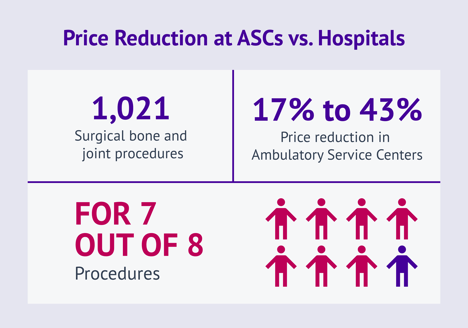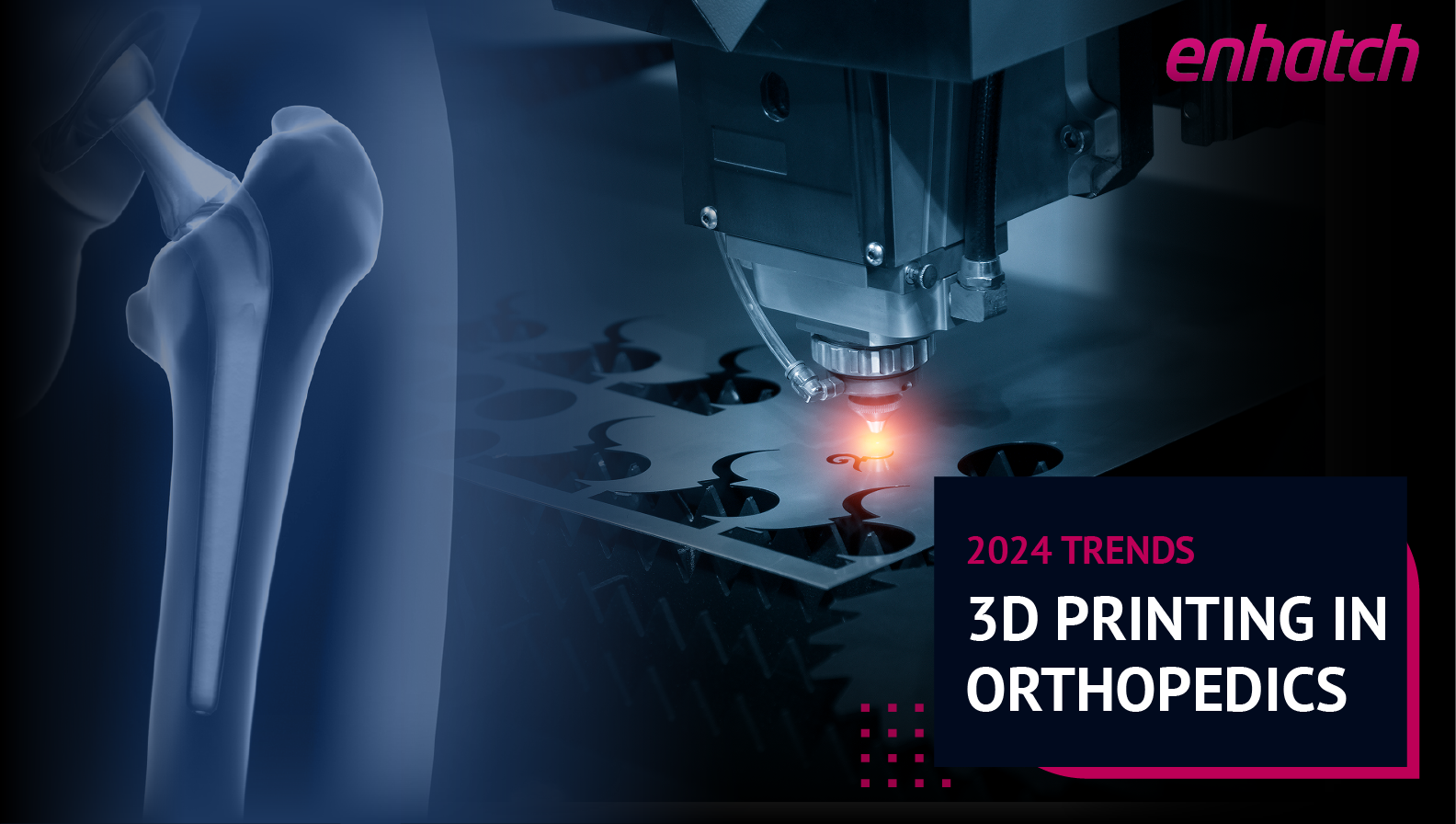Efficiency Imperative: Navigating Orthopedic Surgery Growth in ASCs

The landscape of orthopedic surgeries in the United States is experiencing a profound shift. There has been a staggering increase in procedures performed at ambulatory surgery centers (ASCs).
Data reveals a remarkable surge, with orthopedic procedures constituting a significant portion of ASC caseloads.
- 42,228 procedural cases were reported by ASCs as of November 2023, a staggering 84% increase from 2022 (American Joint Replacement Registry 2023 Annual Report).
- 293% increase in outpatient knee replacement procedures from 2019-2023.
However, this surge in orthopedic procedures at ASCs has its challenges. ASCs and orthopedic surgeons are grappling with issues such as optimizing operational efficiency while ensuring patient safety. While orthopedic procedures have higher reimbursements, performing advanced procedures in outpatient settings involves several complexities.
In addition, orthopedics is already facing a challenge with orthopedic surgeon burnout. Orthopedic surgery residents particularly face a high risk of burnout, with around one in two estimated to be affected by it.
ASCs must think differently and determine ways to increase efficiency to manage these rising procedure volumes.
Adopting innovative technologies to streamline surgical planning, scaling personalized solutions, and integrating AI are some ways ASCs can increase efficiency.
ASC orthopedic procedure growth: Key factors
Orthopedics: Key to sustainable profitable growth at ASCs
According to VMG Health's study, orthopedics generates more revenue than any other specialty nationwide. This study also found that orthopedic cases provide the highest reimbursement to ASCs. Growing orthopedic procedures is an excellent path to sustained profitability for ASCs.
As quoted by John Ryan, CEO of Orthoindy (Indianapolis), in a Beckers ASC review article:
"First, reimbursement for orthopedic cases could always be better, but as reimbursement goes, it is better than several other specialties, making it an attractive specialty to offer at an ASC. Related, I am likely stating the obvious when I say that ASCs with meaningful orthopedic volume stand a much better chance of financial viability and sustainability than those [without]. While it is absolutely possible for an ASC to be financially successful without orthopedics, those ASCs with orthopedic procedure volume at or above 25 percent have a far clearer path to navigate the other economic pressures on an ASC's financial health."
CMS continues to expand orthopedic procedure coverage
CMS continues to expand orthopedic procedure coverage at ASCs. For example, CMS added five more orthopedic codes to its rules for the 2024 payment systems, including total shoulder arthroscopy.
A VGM Health article quotes Bill Prentice, CEO of ASCA:
"We thank CMS for heeding our request to move additional surgical procedures—including total shoulder arthroplasty—onto the ASC payable list. Doing so benefits both Medicare beneficiaries, who now have a lower-cost choice for the care they need, and the Medicare program itself, which will save millions of dollars as volume moves to the high-quality surgery center site of service."
Lower costs for patients
Outpatient procedures eliminate the expenses associated with overnight hospital stays. Hence, the average cost of an orthopedic procedure at ASCs is much lower.
A study's results showed that in 7 of 8 procedures, there was a 17% to 43% price reduction when the surgery was performed at an ASC rather than a hospital. 1,021 surgical bone and joint procedures were examined as part of this study.
Apart from the cost benefits, opting for an ASC offers patients the comfort of recovering at home rather than enduring prolonged hospital stays. Due to these benefits, patients are increasingly preferring surgery at ASCs to hospital settings.

Growth in overall orthopedic procedures
The orthopedic procedure market in the United States is experiencing significant growth, primarily propelled by the aging baby boomer population.
As this demographic cohort ages, the demand for orthopedic interventions, such as joint replacements and spinal surgeries, steadily rises. Concurrently, there's a noticeable shift toward ambulatory surgery centers (ASCs) for such procedures, driven by their cost-effectiveness and efficiency.
Over 68% of orthopedic procedures are expected to be performed at ASCs by mid-2020s. With the overall orthopedic market expanding and more procedures transitioning to ASCs, the future points toward a substantial increase in ASC volume in the coming years.
Navigating surgery demand: The efficiency imperative
Efficiency emerges as a critical imperative in addressing the challenges posed by the growing demand for orthopedics procedures at ASCs.
To ensure continued success and sustainability as preferred sites for orthopedic surgeries, ASCs need to:
- Streamline process.
- Maximize throughput.
- Optimize utilization.
Streamlining preoperative planning, patient-specific solutions, and integrating innovative enabling technologies can enhance efficiency and help overcome these challenges.
Streamlining virtual surgical planning
Effective preoperative planning (also known as virtual surgical planning) is essential for optimizing efficiency in orthopedic surgeries at ASCs. Adopting cutting-edge and intuitive preoperative planning software is key to streamlining this process.
Key factors that can help improve preoperative planning include:
- An easy-to-use planning portal makes it easy for all key stakeholders to collaborate.
- Rapid identification of data issues upon upload.
- Easily customizable workflows that can be used across product lines.
- Advanced imaging techniques and AI integration for 3D modeling.
- Dashboards with complete case visibility for easy tracking of case status.
- Digital approvals which are 21 CFR Part 11 compliant.
An intuitive planning portal with the above features can help reduce preoperative planning time. Surgeons can also anticipate potential challenges, customize surgical approaches, and mitigate risks.
Additionally, involving patients in decision-making and setting realistic expectations fosters a collaborative approach, enhancing patient satisfaction and compliance.
Scale patient-specific solutions
Personalized solutions can help increase efficiency in hospitals and ambulatory surgery centers (ASCs). Adopting innovative technologies can enhance precision and accuracy, which can help reduce surgical time and improve efficiency.
For example, data from studies conducted have shown that:
- 3D-printed anatomical models in orthopedics and maxillofacial surgical procedures can result in an average time saving of 62 minutes per case.
- 3D-printed surgical guides have demonstrated an average time savings of 23 minutes per case.
However, improving surgical planning efficiency and reducing lead times to deliver patient-specific solutions are vital requirements to scale and realize the benefits of patient-specific solutions.
AI integration: Augmenting efficiency in orthopedic surgery
Integrating artificial intelligence (AI) holds immense potential to enhance efficiency in surgical planning. AI can help streamline processes, reduce variability, and improve efficiency across the surgical continuum.
- AI-powered technology can streamline the preoperative planning process by swiftly converting scans, including X-rays, into detailed 3D anatomical models.
- Implant recognition engines can aid in precise assessment of implant size and position, facilitating informed decision-making.
- Data-driven insights can be used to refine surgical approaches and deliver improved outcomes.
Key Takeways
- The trend of orthopedic procedures increasing at ASCs is here to stay.
- As orthopedic procedures continue to increase in ASCs, the imperative for efficiency becomes increasingly important.
- By leveraging strategies like efficient surgical planning, scaling patient-specific solutions, and AI integration, ASCs can navigate the surge in orthopedic surgeries.
- By embracing these innovative solutions, ASCs can reinforce their position as key players in orthopedic care delivery.
- This will ultimately benefit patients, providers, and healthcare systems alike.
Sources
- "Cost Savings From Utilization of an Ambulatory Surgery Center for Orthopaedic Day Surgery", downloaded from the NIH website. Visit page.
- "A Comprehensive Umbrella Review for Understanding Burnout in Orthopaedic Surgery", downloaded from the Sciencedirect website. Visit page.




